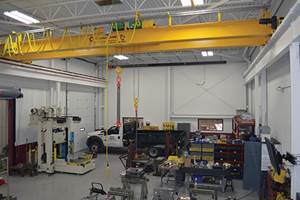Supply Chain Risk, Volatility Offer Opportunity
As I write this, reports are circulating about the U.S. economy showing signs of rebounding. But until unemployment begins to rise with any significance and housing foreclosures slow down, I’m skeptical. Without demand, there’s no supply. But as precarious as things are—and as far as U.S. manufacturing has suffered during and before this Great Recession—opportunities do still exist for machining businesses in the U.S.
Those opportunities come in the form of supply chain instability, and are exposed in part by survey data released by AMR Research in a report titled “Supply Chain Risk, 2008-2009: As Bad As It Gets” (tinyurl.com/o6u8wk).
The main point of this report is that the perceptions and priorities of risks have changed dramatically over the past year. Supply chain management—including buyers and purchasing executives who are your prospects—have recognized risks that undermine previous decisions, like outsourcing many products and projects.
For instance, last year’s AMR report indicated that supply chain professionals were deeply concerned about logistics and transportation costs due to the cost of oil and commodities. In that same report, supplier failure was ranked low among the same group.
But this year, with oil prices dropping and credit nearly impossible to obtain, the two have switched. As a matter of fact, supplier failure was ranked as the number one concern this year, rising dramatically from last year (transportation costs dropped to the middle of the pack, but more on that in a moment).
The top three risks as ranked by the survey participants are: supplier failure, commodity price volatility and internal product quality failures. Suppliers. Material costs. Quality. If this combination doesn’t offer manufacturers in the U.S. an opportunity to get a foot in the door of customers, I don’t know what else will.
AMR goes on to present data from the survey that identifies the highest risks to supply chain professionals in China and in the U.S. The top three risks that bring the most concern in China are: intellectual property infringement, supplier quality failures and internal quality failures. In the U.S., the top three risks identified are: lower consumer spend, volatile energy costs and volatile commodity prices.
AMR also says that “… companies are leaving China for onshore or nearshore sources, but it remains dominant as a supply center … proportionally to the United States, Chinese supply and manufacturing sources are dramatically worse across the board.”
Volatility is the point. For example, it’s not that oil prices (and, therefore, transportation costs) are lower today; it’s that companies must react frequently to sporadic costs. And that adds cost. Reacting to and managing all these risks are becoming less attractive to many companies, and they’re looking to reduce the costs and strain. And there’s the opportunity. But you must capitalize as supply options are being reconsidered.
Now is the time to call or contact previous customers who have outsourced work, and let them know you’re here. Share with them the data from this report and how you offer solutions that are actually more affordable and risk-free than the total landed cost of an outsourced product.
Use your Web site and other marketing channels to promote your value to companies and prospects in the context of stability and reliability. Give them specifics of projects and products that show your strengths in these areas.
Volatility has caused buyers to look for alternatives, but they likely won’t know you’re there if you don’t tell them.
Related Content
Editorial Guidelines: Editorial Advisory Board
The Editorial Advisory Board of MoldMaking Technology is made up of authorities with expertise within their respective business, industry, technology and profession. Their role is to advise on timely issues, trends, advances in the field, offer editorial thought and direction, review and comment on specific articles and generally act as a sounding board and a conscience for the publication.
Read MoreThe Role of Social Media in Manufacturing
Charles Daniels CFO of Wepco Plastics shares insights on the role of social media in manufacturing, how to improve the “business” side of a small mold shop and continually developing culture.
Read MoreMaking Mentoring Work | MMT Chat Part 2
Three of the TK Mold and Engineering team in Romeo, Michigan join me for Part 2 of this MMT Chat on mentorship by sharing how the AMBA’s Meet a Mentor Program works, lessons learned (and applied) and the way your shop can join this effort.
Read MoreThe Trifecta of Competitive Toolmaking
Process, technology and people form the foundations of the business philosophy in place at Eifel Mold & Engineering.
Read MoreRead Next
How Online Communities Can Help Businesses, Part 2
This month, I want to explore the advantages online communities can provide for your own Web site’s visibility and prominence, resulting in more exposure to motivated prospects and more leads.
Read MoreHow to Use Strategic Planning Tools, Data to Manage the Human Side of Business
Q&A with Marion Wells, MMT EAB member and founder of Human Asset Management.
Read MoreReasons to Use Fiber Lasers for Mold Cleaning
Fiber lasers offer a simplicity, speed, control and portability, minimizing mold cleaning risks.
Read More



















